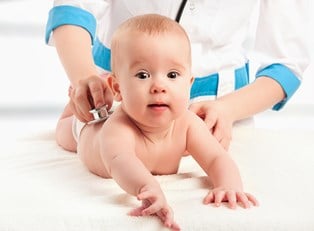Infantile jaundice is a relatively common issue in newborns, most recognizable by a yellow tint to external tissues. This may be particularly true in areas with higher elevation, because of the decreased oxygen levels in the air. In most cases, infantile jaundice clears up quickly and without complication, but this doesn’t mean you shouldn’t talk to your newborn’s doctor if you notice the signs. Here’s a look at the causes, symptoms, and treatment of infantile jaundice.
Causes
Jaundice is itself a symptom, generally of a liver disorder, characterized by a yellow cast to the skin and eyes. Bilirubin is a substance excreted by the liver; it occurs in red blood cells, has a yellow pigment, and develops when red blood cells break down. Many babies develop the yellow skin characteristic because their liver is insufficiently developed and cannot excrete bilirubin as effectively as it should. Rather than breaking down the bilirubin and excreting it, bilirubin builds up in the blood stream.
Infantile jaundice can develop for several reasons, but is particularly common for preterm infants (those born before 38 weeks of pregnancy). For some babies, however, infantile jaundice is part of a larger issue. Rather than just needing a few more days to work properly, the liver may have a more permanent dysfunction. Enzyme deficiencies and abnormalities of the red blood cells can also be underlying conditions leading to jaundice in newborns. Some infections (such as sepsis), mother/child blood incompatibility, and internal bleeding can all also cause jaundice in newborns.
Symptoms
The timing of the appearance of jaundice is one of the most distinct characteristics that allows healthcare providers (and worried parents) to suspect a serious issue rather than an underdeveloped liver. Physiologic jaundice refers to infantile jaundice that develops in otherwise healthy babies with an insufficiently developed liver. The yellowish discoloration appears on the second or third day after birth.
Jaundice caused by more severe conditions generally occurs much sooner or later than physiologic jaundice, according to the Mayo Clinic. Because jaundice itself is a symptom, rather than a disease or cause, it doesn’t necessarily have corresponding “symptoms” to suggest its presence. However, if jaundice is caused by an underlying condition, there may be other symptoms present.
Treatment
Most cases of mild, physiologic infantile jaundice clear up on their own in under a month. However, some babies do have to stay in the hospital a little longer. The goal of treatments for jaundice is to decrease the amount of bilirubin in the newborn’s blood. Light therapy, also called phototherapy, involves directing non-ultraviolet light at the infant. The particular light used changes the bilirubin in such a way the infant can actually excrete it.
When mother and child have different blood types, treatment may require Intravenous immunoglobulin. Essentially, the difference in the blood type means maternal blood can carry antibodies that make the baby’s blood cells break down. Immunoglobulin can decrease the antibodies causing the reaction. When this doesn’t work, it may be necessary for the infant to receive a blood transfusion, in which blood is withdrawn, diluted, and returned -- with less bilirubin and antibodies -- to the infant. When infantile jaundice is caused by other issues, further treatment may be necessary to prevent complications.
Recognizing Jaundice
During the initial hospital stay, most neonatal nurses check newborns regularly for beginning signs of jaundice. Aside from this, experts recommend a trip to the pediatrician in the first few days of being home. Bilirubin levels are at their highest in the first week of life, making these initial visits critical for recognizing jaundice. If you’re concerned, find an area with good lighting, then gently press the skin of your newborn’s forehead and carefully note the color in the area of the indentation. If you notice any yellow discoloration, call your pediatrician immediately.



